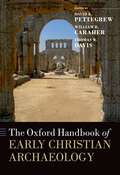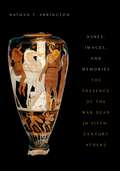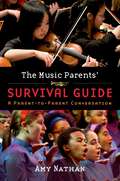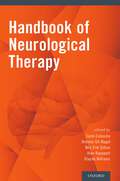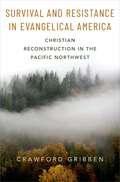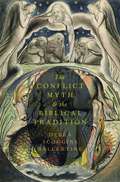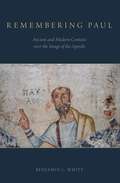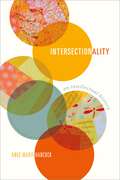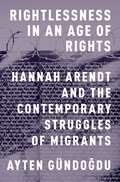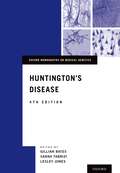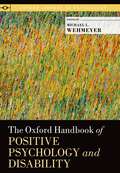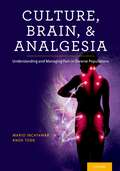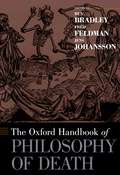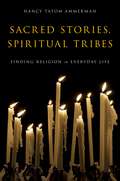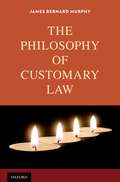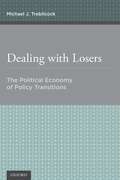- Table View
- List View
The Oxford Handbook of Early Christian Archaeology (Oxford Handbooks)
The Oxford Handbook of Early Christian Archaeology brings together expert work by leading scholars of the archaeology of Early Christianity and the Roman world in the Mediterranean and surrounding regions. The thirty-four contributions to this volume survey Christian material culture and ground the history, culture, and society of the first seven centuries of Christianity in archaeological method, theory, and research. The essays emphasize the link between archaeological fieldwork, methods, and regional and national traditions in constructing our knowledge of the Early Church and Christian communities within the context of the ancient Mediterranean, Near East, and Europe. Three sweeping introductory essays provide historical perspectives on the archaeology of the Early Christian world. These are followed by a series of topical treatments that focus on monuments and environments ranging from Christian churches to catacombs, martyria, and baths, as well as classes of objects of religious significance such as ceramics, lamps, and icons. Finally, the volume locates the archaeology of the Early Christian world in fifteen regional studies stretching from Britain to Persia, highlighting the unique historical contexts that have shaped scholarly discussion across time and space. The thorough, carefully-researched essays offer the most intensive, state-of-the-art treatment of recent research into the archaeology of Early Christianity available.
Ashes, Images, and Memories: The Presence of the War Dead in Fifth-Century Athens
by Nathan T. ArringtonAshes, Images, and Memories argues that the institution of public burial for the war dead and images of the deceased in civic and sacred spaces fundamentally changed how people conceived of military casualties in fifth-century Athens. In a period characterized by war and the threat of civil strife, the nascent democracy claimed the fallen for the city and commemorated them with rituals and images that shaped a civic ideology of struggle and self-sacrifice on behalf of a unified community. While most studies of Athenian public burial have focused on discrete aspects of the institution, such as the funeral oration, this book broadens the scope. It examines the presence of the war dead in cemeteries, civic and sacred spaces, the home, and the mind, and underscores the role of material culture - from casualty lists to white-ground lekythoi-in mediating that presence. This approach reveals that public rites and monuments shaped memories of the war dead at the collective and individual levels, spurring private commemorations that both engaged with and critiqued the new ideals and the city's claims to the body of the warrior. Faced with a collective notion of "the fallen" families asserted the qualities, virtues, and family links of the individual deceased, and sought to recover opportunities for private commemoration and personal remembrance. Contestation over the presence and memory of the dead often followed class lines, with the elite claiming service and leadership to the community while at the same time reviving Archaic and aristocratic commemorative discourses. Although Classical Greek art tends to be viewed as a monolithic if evolving whole, this book depicts a fragmented and charged visual world.
The Music Parents' Survival Guide: A Parent-to-Parent Conversation
by Amy NathanThis book of parent-to-parent advice aims to encourage, support, and bolster the morale of one of music's most important back-up sections: music parents. Within these pages, more than 150 veteran music parents contribute their experiences, reflections, warnings, and helpful suggestions for how to walk the music-parenting tightrope: how to be supportive but not overbearing, and how to encourage excellence without becoming bogged down in frustration. Among those offering advice are the parents of several top musicians, including the mother of violinist Joshua Bell, the father of trumpeter Wynton Marsalis, the parents of cellist Alisa Weilerstein, and those of violinist Anne Akiko Meyers. The book also features advice from music educators and more than forty professional musicians, including Paula Robison, Sarah Chang, Anthony McGill, Jennifer Koh, Jonathan Biss, Toyin Spellman-Diaz, Marin Alsop, Christian McBride, Miguel Zenón, Stephanie Blythe, Lawrence Brownlee, Kelli O'Hara, as well as Joshua Bell, Alisa Weilerstein, Wynton Marsalis, Anne Akiko Meyers, and others. The topics they discuss span a wide range of issues faced by the parents of both instrumentalists and singers, from how to get started and encourage effective practice habits, to how to weather the rough spots, cope with the cost of music training, deal with college and career concerns, and help young musicians discover the role that music can play in their lives. The parents who speak here reach a unanimous and overwhelming conclusion that music parenting is well worth the effort, and the experiences that come with it - from sitting in on early lessons and watching their kids perform onstage to tagging along at music conventions as their youngsters try out instruments at exhibitors' booths - enrich family life with a unique joy in music.
Handbook of Neurological Therapy
by Carlo Colosimo Antonio Gil-Nagel Nils Erik Gilhus Alan Rapoport Olajide WilliamsThis is a practical book on neurological therapy. It is aimed at giving concise and updated answers to busy practicing clinicians in the clinic, ward, or emergency department. An evidence-based approach is used, but when there is no evidence or the data are inconclusive, an expert opinion is always given in order to meet the expectations of the reader. All neurological conditions, common and less common, are discussed; each chapter has a similar format, and contains an initial brief introduction on the epidemiology and clinical features of each disease. The therapy is then discussed, including pharmacological and non-pharmacological, with wide use of Tables & Figures. Flowcharts are also included in most of the chapters.
Handbook of Neurological Therapy
by Carlo Colosimo, Antonio Gil–Nagel, Nils Erik Gilhus, Alan Rapoport and Olajide WilliamsHandbook of Neurological Therapy
by Carlo Colosimo, Antonio Gil–Nagel, Nils Erik Gilhus, Alan Rapoport and Olajide WilliamsThis is a practical book on neurological therapy. It is aimed at giving concise and updated answers to busy practicing clinicians in the clinic, ward, or emergency department. An evidence-based approach is used, but when there is no evidence or the data are inconclusive, an expert opinion is always given in order to meet the expectations of the reader. All neurological conditions, common and less common, are discussed; each chapter has a similar format, and contains an initial brief introduction on the epidemiology and clinical features of each disease. The therapy is then discussed, including pharmacological and non-pharmacological, with wide use of Tables & Figures. Flowcharts are also included in most of the chapters.
Survival and Resistance in Evangelical America: Christian Reconstruction in the Pacific Northwest
by Crawford GribbenOver the last thirty years, conservative evangelicals have been moving to the Northwest of the United States, where they hope to resist the impact of secular modernity and to survive the breakdown of society that they anticipate. These believers have often given up on the politics of the Christian Right, adopting strategies of hibernation while developing the communities and institutions from which a new America might one day emerge. Their activity coincides with the promotion by prominent survivalist authors of a program of migration to the "American Redoubt," a region encompassing Idaho, Montana, parts of eastern Washington and Oregon, and Wyoming, as a haven in which to endure hostile social change or natural disaster and in which to build a new social order. These migration movements have independent origins, but they overlap in their influences and aspirations, working in tandem to offer a vision of the present in which Christian values must be defended as American society is rebuilt according to biblical law. This book examines the origins, evolution, and cultural reach of this little-noted migration and considers what it might tell us about the future of American evangelicalism. Drawing on Calvinist theology, the social theory of Christian Reconstruction, and libertarian politics, these believers are projecting significant soft power. Their books are promoted by leading mainstream publishers and listed as New York Times bestsellers. Their strategy is gaining momentum, making an impact in local political and economic life, while being repackaged for a wider audience in publications by a broader coalition of conservative commentators and in American mass culture. This survivalist evangelical subculture recognizes that they have lost the culture war - but another kind of conflict is beginning.
Survival and Resistance in Evangelical America: Christian Reconstruction in the Pacific Northwest
by Crawford GribbenOver the last thirty years, conservative evangelicals have been moving to the Northwest of the United States, where they hope to resist the impact of secular modernity and to survive the breakdown of society that they anticipate. These believers have often given up on the politics of the Christian Right, adopting strategies of hibernation while developing the communities and institutions from which a new America might one day emerge. Their activity coincides with the promotion by prominent survivalist authors of a program of migration to the "American Redoubt," a region encompassing Idaho, Montana, parts of eastern Washington and Oregon, and Wyoming, as a haven in which to endure hostile social change or natural disaster and in which to build a new social order. These migration movements have independent origins, but they overlap in their influences and aspirations, working in tandem to offer a vision of the present in which Christian values must be defended as American society is rebuilt according to biblical law. This book examines the origins, evolution, and cultural reach of this little-noted migration and considers what it might tell us about the future of American evangelicalism. Drawing on Calvinist theology, the social theory of Christian Reconstruction, and libertarian politics, these believers are projecting significant soft power. Their books are promoted by leading mainstream publishers and listed as New York Times bestsellers. Their strategy is gaining momentum, making an impact in local political and economic life, while being repackaged for a wider audience in publications by a broader coalition of conservative commentators and in American mass culture. This survivalist evangelical subculture recognizes that they have lost the culture war - but another kind of conflict is beginning.
The Conflict Myth and the Biblical Tradition
by Debra Scoggins BallentineThere are many ancient West Asian stories that narrate the victory of a warrior deity over an enemy, typically a sea-god or sea dragon, and his rise to divine kingship. In The Conflict Myth and the Biblical Tradition, Debra Scoggins Ballentine analyzes this motif, arguing that it was used within ancient political and socio-religious discourses to bolster particular divine hierarchies, kings, institutions, and groups, as well as to attack others. Situating her study of the conflict topos within contemporary theorizations of myth by Bruce Lincoln, Russell McCutcheon, and Jonathan Z. Smith, Ballentine examines narratives of divine combat and instances of this conflict motif. Her study cuts across traditional disciplinary boundaries as well as constructed time periods, focusing not only on the Hebrew Bible but also incorporating Mesopotamian, early Jewish, early Christian, and rabbinic texts, spanning a period of almost three millennia - from the eighteenth century BCE to the early middle ages CE. The Conflict Myth and the Biblical Tradition advances our understanding of the conflict topos in ancient west Asian and early Jewish and Christian literatures and of how mythological and religious ideas are used both to validate and render normative particular ideologies and socio-political arrangements, and to delegitimize and invalidate others.
Remembering Paul: Ancient and Modern Contests over the Image of the Apostle
by Benjamin L. WhiteWho was Paul of Tarsus? Radical visionary of a new age? Gender-liberating progressive? Great defender of orthodoxy? In Remembering Paul, Benjamin L. White offers a critique of early Christian claims about the "real" Paul in the second century C.E.--a period in which apostolic memory was highly contested--and sets these ancient contests alongside their modern counterpart: attempts to rescue the "historical" Paul from his "canonical" entrapments. White charts the rise and fall of various narratives about Paul and argues that Christians of the second century had no access to the "real" Paul. Through the selection, combination, and interpretation of pieces of a diverse earlier layer of the Pauline tradition, Christians defended images of the Apostle that were important for forming collective identity.
Intersectionality: An Intellectual History
by Ange-Marie HancockIntersectionality theory has emerged over the past thirty years as a way to think about the avenues by which inequalities (most often dealing with, but not limited to, race, gender, class and sexuality) are produced. Rather than seeing such categories as signaling distinct identities that can be adopted, imposed or rejected, intersectionality theory considers the logic by which each of these categories is socially constructed as well as how they operate within the diffusion of power relations. In other words, social and political power are conferred through categories of identity, and these identities bear vastly material effects. Rather than look at inequalities as a relationship between those at the center and those on the margins, intersectionality maps the relative ways in which identity politics create power. Though intersectionality theory has emerged as a highly influential school of thought in ethnic studies, gender studies, law, political science, sociology and psychology, no scholarship to date exists on the evolution of the theory. In the absence of a comprehensive intellectual history of the theory, it is often discussed in vague, ahistorical terms. And while scholars have called for greater specificity and attention to the historical foundations of intersectionality theory, their idea of the history to be included is generally limited to the particular currents in the United States. This book seeks to remedy the vagueness and murkiness attributed to intersectionality by attending to the historical, geographical, and cross-disciplinary myopia afflicting current intersectionality scholarship. This comprehensive intellectual history is an agenda-setting work for the theory.
INTERSECTIONAL AN INTELLEC HIST C: An Intellectual History
by Ange-Marie HancockIntersectionality theory has emerged over the past thirty years as a way to think about the avenues by which inequalities (most often dealing with, but not limited to, race, gender, class and sexuality) are produced. Rather than seeing such categories as signaling distinct identities that can be adopted, imposed or rejected, intersectionality theory considers the logic by which each of these categories is socially constructed as well as how they operate within the diffusion of power relations. In other words, social and political power are conferred through categories of identity, and these identities bear vastly material effects. Rather than look at inequalities as a relationship between those at the center and those on the margins, intersectionality maps the relative ways in which identity politics create power. Though intersectionality theory has emerged as a highly influential school of thought in ethnic studies, gender studies, law, political science, sociology and psychology, no scholarship to date exists on the evolution of the theory. In the absence of a comprehensive intellectual history of the theory, it is often discussed in vague, ahistorical terms. And while scholars have called for greater specificity and attention to the historical foundations of intersectionality theory, their idea of the history to be included is generally limited to the particular currents in the United States. This book seeks to remedy the vagueness and murkiness attributed to intersectionality by attending to the historical, geographical, and cross-disciplinary myopia afflicting current intersectionality scholarship. This comprehensive intellectual history is an agenda-setting work for the theory.
Rightlessness in an Age of Rights: Hannah Arendt and the Contemporary Struggles of Migrants
by Ayten GündogduThere have been remarkable developments in the field of human rights in the past few decades. Still, millions of asylum-seekers, refugees, and undocumented immigrants continue to find it challenging to access human rights. In this book, Ayten Gündogdu builds on Hannah Arendt's analysis of statelessness and argues that these challenges reveal the perplexities of human rights. Human rights promise equal personhood regardless of citizenship status, yet their existing formulations are tied to the principle of territorial sovereignty. This situation leaves various categories of migrants in a condition of "rightlessness," with a very precarious legal, political, and human standing. Gündogdu examines this problem in the context of immigration detention, deportation, and refugee camps. Critical of the existing system of human rights without seeing it as a dead end, she argues for the need to pay closer attention to the political practices of migrants who challenge their condition of rightlessness and propose new understandings of human rights. What arises from this critical reflection on human rights is also a novel reading of Arendt, one that offers refreshing insights into various dimensions of her political thought, including her account of the human condition, "the social question," and "the right to have rights." Rightlessness in an Age of Rights is a valuable addition to the literature on Hannah Arendt and a vital way of rethinking human rights as they relate to contemporary issues of immigration.
Huntington's Disease (Oxford Monographs on Medical Genetics)
by Gillian Bates & Sarah Tabrizi & Lesley JonesThis fourth edition of Huntington's Disease presents a comprehensive summary of the current knowledge of this disease, including the major scientific and clinical advances that have occurred since publication of the third edition in 2002. Completely updated and expanded, chapters in this volume are organized in five sections: · Clinical aspects of Huntington's disease, including updated chapters on historical perspectives, neurological, neuropsychiatric, and neuropsychological aspects, and new chapters on juvenile Huntington's and the premanifest and early stages · The genetics of Huntington's disease, including new information on its epidemiology discussions of new testing guidelines · Neurobiology, including recent insights into correlations between pathology and symptoms and a new chapter on neuronal circuitry · The molecular biology of Huntington's disease, including new chapters on the normal function of huntingtin, the molecular pathogenesis of Huntington's disease and the peripheral pathology of the disorder, and an extensively updated chapter on its structural biology · An updated description of the comprehensive care for Huntington's disease, featureing a new chapter on preclinical therapeutics and a completely rewritten chapter on the state of the art of experimental therapeutics and clinical trials.
The Oxford Handbook of Positive Psychology and Disability (Oxford Library of Psychology)
Roughly 54 million people with disabilities live in the U.S., and there are many more millions of people with disabilities around the world. Not surprisingly, differences among and between people with disabilities are often as notable as differences between people with and without disabilities. And, while the lack of homogeneity among people with disabilities makes creating a valid taxonomy under this term difficult, if not impossible, there is commonality among and between people with disabilities that justifies an authoritative resource on positive psychology and disability. That is, they have experienced discrimination and marginalization as a function of their disability. This volume assembles chapters by leading scholars in the fields of disability and positive psychology to provide a comprehensive synthesis of the state of the field of positive psychology and disability. Chapters are organized into thematic sections, beginning with an introductory section providing information on overarching themes in positive psychology and disability. The second section highlights the application of positive psychological constructs to disability, including quality of life, self-determination, adaptive behavior, optimism, hope, problem solving, forgiveness, gratitude, and spirituality. The following section addresses systemic issues in disability that impact positive psychology, again turning to disciplines beyond just psychology (special education, rehabilitation sciences, family, and disability policy) to address areas in which positive psychology can be applied. A fourth section examines positive psychology in specific disabled populations, including physical disabilities, cognitive and developmental disabilities, severe multiple disabilities, emotional and behavioral disabilities, and autism spectrum disorders. Disability has always been associated with "differentness" and, consequently, people with disabilities have, throughout time, been treated as such. As the first handbook to consider disability from a strengths-based perspective, this volume provides a catalyst to accelerate the application of positive psychology with regard to how disability is understood.
Culture, Brain, and Analgesia: Understanding and Managing Pain in Diverse Populations
by Mario Incayawar Knox H. ToddIn this book, the authors have placed culture in the forefront of their approach to study pain in an integrative manner. Culture should not be considered solely for knowing more about patients' values, beliefs, and practices. It should be studied with the purpose of unveiling its effects upon biological systems and the pain neuromatrix. The book discusses how a multidisciplinary and integrative approach to pain and analgesia should be considered. Some familiarity with the cultural background of patients and awareness of the provider's own cultural characteristics will allow the pain practitioner to better understand patients' values, attitudes and preferences. Knowledge of patients' cultural practices will allow determining the impact of culture on biological processes, including the origin and development of pain-related disease, and the patients' response to pharmacological and non-pharmacological treatments. Acknowledging the interactions of molecules, genes and culture could yield a more appropriate and effective personalized pain medicine. Furthermore, this approach has the potential to transform the way pain medicine is taught to young students and future pain professionals, and in so doing meet the need of trained clinicians who are versed in multiple disciplines and are able to use an integrative approach to diagnose and treat pain. A personalized medicine will have non-negligible positive effects in improving doctor patient relationships, patient satisfaction, adherence to treatment plans, and health outcomes and inequities. It is hoped that the material in this volume will appeal to a broad cross-section of health practitioners, students and academicians, including pain medicine specialists, psychiatrists, psychologists, social workers, mental health, community and public health workers, health policy makers, and health administrators.
The Oxford Handbook of Philosophy of Death (Oxford Handbooks)
Death has long been a pre-occupation of philosophers, and this is especially so today. The Oxford Handbook of Philosophy of Death collects 21 newly commissioned essays that cover current philosophical thinking of death-related topics across the entire range of the discipline. These include metaphysical topics--such as the nature of death, the possibility of an afterlife, the nature of persons, and how our thinking about time affects what we think about death--as well as axiological topics, such as whether death is bad for its victim, what makes it bad to die, what attitude it is fitting to take towards death, the possibility of posthumous harm, and the desirability of immortality. The contributors also explore the views of ancient philosophers such as Aristotle, Plato and Epicurus on topics related to the philosophy of death, and questions in normative ethics, such as what makes killing wrong when it is wrong, and whether it is wrong to kill fetuses, non-human animals, combatants in war, and convicted murderers. With chapters written by a wide range of experts in metaphysics, ethics, and conceptual analysis, and designed to give the reader a comprehensive view of recent developments in the philosophical study of death, this Handbook will appeal to a broad audience in philosophy, particularly in ethics and metaphysics.
Sacred Stories, Spiritual Tribes: Finding Religion in Everyday Life
by Nancy Tatom AmmermanNancy Tatom Ammerman examines the stories Americans tell of their everyday lives, from dinner table to office and shopping mall to doctor's office, about the things that matter most to them and the routines they take for granted, and the times and places where the everyday and ordinary meet the spiritual. In addition to interviews and observation, Ammerman bases her findings on a photo elicitation exercise and oral diaries, offering a window into the presence and absence of religion and spirituality in ordinary lives and in ordinary physical and social spaces. The stories come from a diverse array of ninety-five Americans -- both conservative and liberal white Protestants, African American Protestants, Catholics, Jews, Mormons, Wiccans, and people who claim no religious or spiritual proclivities -- across a range that stretches from committed religious believers to the spiritually neutral. Ammerman surveys how these people talk about what spirituality is, how they seek and find experiences they deem spiritual, and whether and how religious traditions and institutions are part of their spiritual lives.
The Philosophy of Customary Law
by James Bernard MurphyAlthough many modern philosophers of law describe custom as merely a minor source of law, formal law is actually only one source of the legal customs that govern us. Many laws grow out of custom, and one measure of a law's success is by its creation of an enduring legal custom. Yet custom and customary law have long been neglected topics in unsettled jurisprudential debate. Smaller concerns, such as whether customs can be legitimized by practice or by stipulation, stipulated by an authority or by general consent, or dictated by law or vice versa, lead to broader questions of law and custom as alternative or mutually exclusive modes of social regulation, and whether rational reflection in general ought to replace sub-rational prejudice. Can legal rules function without customary usage, and does custom even matter in society? The Philosophy of Customary Law brings greater theoretical clarity to the often murky topic of custom by showing that custom must be analyzed into two more logically basic concepts: convention and habit. James Bernard Murphy explores the nature and significance of custom and customary law, and how conventions relate to habits in the four classic theories of Aristotle, Francisco Suarez, Jeremy Bentham, and James C. Carter. He establishes that customs are conventional habits and habitual conventions, and allows us to better grasp the many roles that custom plays in a legal system by offering a new foundation of understanding for these concepts.
Dealing with Losers: The Political Economy of Policy Transitions
by Professor Michael J. TrebilcockWhenever governments change policies--tax, expenditure, or regulatory policies, among others--there will typically be losers: people or groups who relied upon and invested in physical, financial, or human capital predicated on, or even deliberately induced by the pre-reform set of policies. The issue of whether and when to mitigate the costs associated with policy changes, either through explicit government compensation, grandfathering, phased or postponed implementation, is ubiquitous across the policy landscape. Much of the existing literature covers government takings, yet compensation for expropriation comprises merely a tiny part of the universe of such strategies. Dealing with Losers: The Political Economy of Policy Transitions explores both normative and political rationales for transition cost mitigation strategies and explains which strategies might create an aggregate, overall enhancement in societal welfare beyond mere compensation. Professor Michael J. Trebilcock highlights the political rationales for mitigating such costs and the ability of potential losers to mobilize and obstruct socially beneficial changes in the absence of well-crafted transition cost mitigation strategies. This book explores the political economy of transition cost mitigation strategies in a wide variety of policy contexts including public pensions, U.S. home mortgage interest deductions, immigration, trade liberalization, agricultural supply management, and climate change, providing tested examples and realistic strategies for genuine policy reform.
